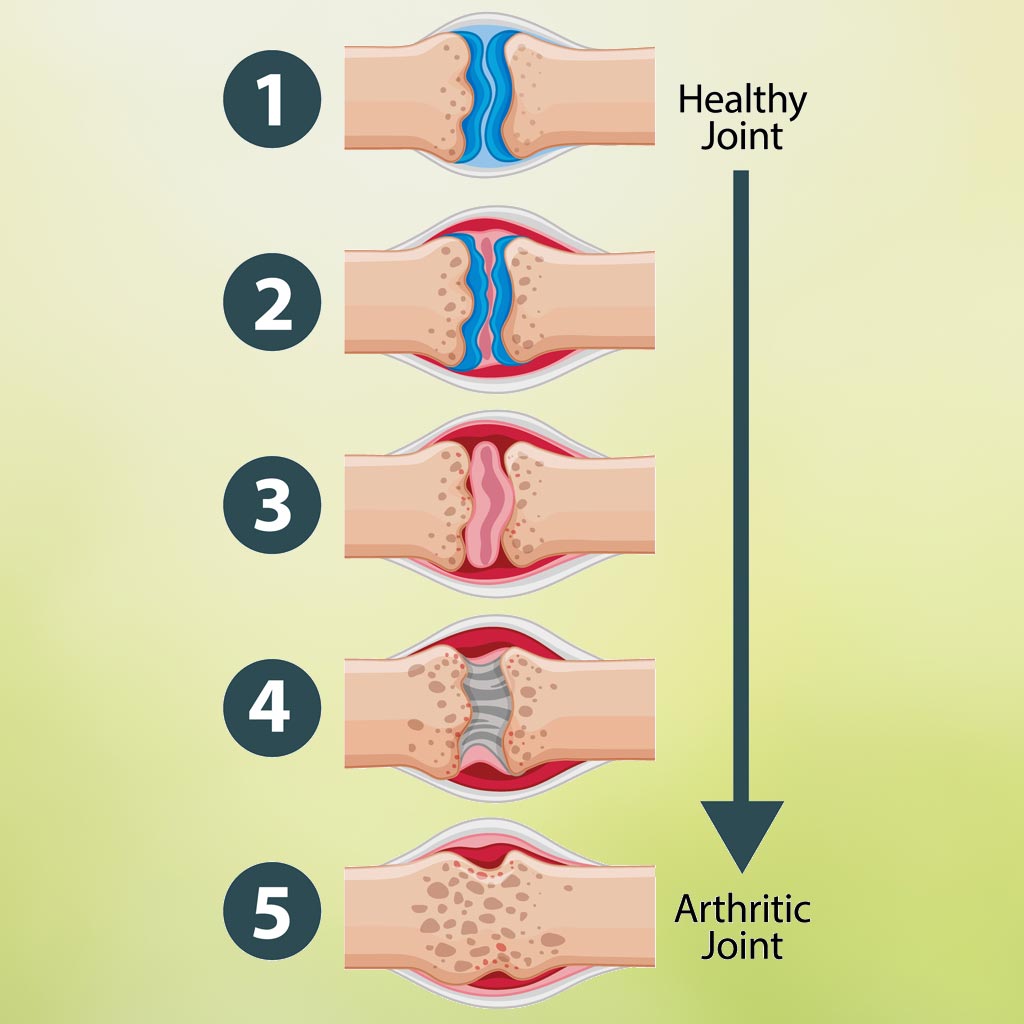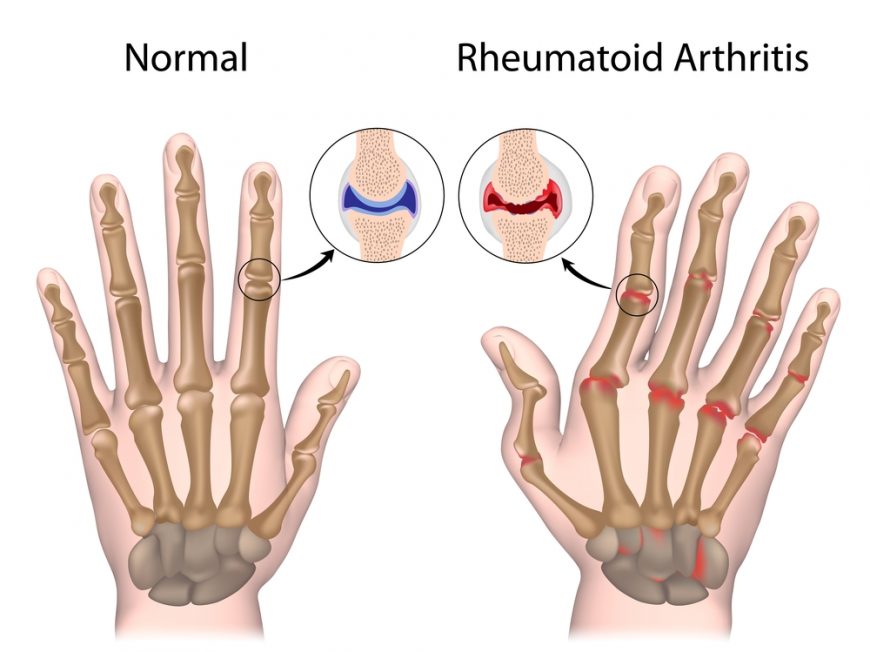The four common types of arthritis are osteoarthritis, a bone degeneration disease; rheumatoid arthritis and psoriatic arthritis, autoimmune diseases; and gout. The causes of the different arthritis types differ, but all patients will likely experience periodic flare-ups. A flare or flare-up is a sudden and temporary increase in disease activity during which symptoms worsen. It is a normal but usually very painful event.
What is the Cause of Arthritis?
According to the Arthritis Foundation, a conservative estimate of the number of adults who have arthritis, diagnosed by a doctor, is 54 million. Tens of millions of these people experience flare-ups each day. Understanding what triggers arthritis is important to understanding what happens during a flare-up.
- Rheumatoid arthritis
What causes rheumatoid arthritis? This type of arthritis is an autoimmune disease, meaning the body’s immune system attacks joint linings (synovium) and a host of other systems and tissues that include blood vessels, heart, lungs, eyes, skin, nerves and kidneys. The synovium thickens due to inflammation and causes destruction of the cartilage and bones, also stretching the tendons and ligaments, which leads to joint misalignment.

- Osteoarthritis
Called the wear-and-tear arthritis, osteoarthritis is when the cartilage that serves as a cushion between bones wears away and bones rub together, inflaming surrounding tissues. Cartilage deterioration can also cause the joint lining to become inflamed and the joint cavity to fill with fluid in response.
- Psoriatic arthritis
This is an inflammatory arthritis. Like rheumatoid arthritis, the body’s immune system attacks healthy tissue and cells. It develops in some people who have psoriasis, a skin condition that presents itself as red patches of skin with silvery scales. Usually, the psoriasis appears first, and the arthritis develop afterwards, but psoriatic arthritis can begin first.
- Gout
Gout is an arthritis caused by uric acid crystals building up in a joint. After eating some foods, purines are broken down and one of the elements produced is uric acid. The crystals irritate joints but can also lead to kidney stones and even kidney failure. The most common joint experiencing gout is the joint at the base of the big toe, but it can also affect elbows, wrists, fingers, knees and ankles.
Symptoms of an Arthritis Flare
There are some arthritis flare symptoms found in every type of arthritis, like extreme joint pain and stiffness. Morning joint stiffness is a common symptom for rheumatoid arthritis, osteoarthritis and psoriatic arthritis. However, each type of arthritis also has symptoms unique to the particular arthritis. For example, rheumatoid arthritis is symmetric, meaning it usually affects both sides of the body, like both hands, both knees and/or both feet. Following are some of the typical symptoms of each type of arthritis.
Rheumatoid arthritis – joint pain and swelling; joint is warm to the touch; joint stiffness; fatigue; joint redness; loss of appetite; low-grade fever; limited range of joint motion; symmetrical joint effect.
Osteoarthritis – joint pain and stiffness; joint swelling can occur but is not as common as it is in people with rheumatoid arthritis; fatigue, often induced by pain experienced during the night that keeps a person awake; may affect a joint on one side of the body, like one knee or one ankle.
Psoriatic arthritis – joint pain, swelling and stiffness; joint is warm to the touch; most likely to cause foot pain where ligaments and tendons attach to the bones, swollen fingers and toes and/or lower back pain (spondylitis).
Gout – develops quickly, and the joint becomes very painful; joint swelling, warmth, reddish discoloration, and tenderness.

Arthritis may be a joint disease, but flare ups can create other health issues, like extreme fatigue and a general feeling of sickness. People often find it difficult to explain their many symptoms, and each person is unique. Every flare should be taken seriously.
Triggers for Flare Ups
Rheumatoid arthritis – An RA flare is primarily due to inflammation, but what triggers inflammation? The triggers for inflammation are not specifically known yet, though extensive medical research is in progress. It may be stress, weather or too much physical activity. There is no definitive medical research proving weather impacts arthritis. Still, many patients have noted their joints react to a change in barometric pressure and humidity or when it is cold. Other triggers include infection or any illness compromising the immune system, and medications.
Osteoarthritis – Flare-ups are not triggered by inflammation from an immune system response, but inflammation may be one of the symptoms of an osteoarthritis flare. Scientifically proven flare triggers still do not exist, but there are certain activities that have often triggered flare-ups. They include falling on or injuring a joint, repetitive motions, and overuse. Other causes include infection, stress, weather and obesity or being overweight. In some cases, continued deterioration of the cartilage can lead to bone spurs developing which then further irritates the joint and possibly the surrounding tissue.
Psoriatic arthritis – Most people experience a flare of psoriasis before a flare of psoriatic arthritis. The suspected triggers for a flare are stress, weight gain, physical trauma, joint strain, infection, and medications.
Gout – The triggers for gout include excessive weight gain or obesity, alcohol, high blood pressure, abnormal kidney functioning, medications, disease and low thyroid hormone levels.
Foods that Cause Arthritis Flare-Ups
Specific foods are not scientifically proven to trigger inflammation, but lab tests are indicating there are foods that appear to be pro-inflammatory. Foods to avoid include red meat, fried foods, processed food, refined carbohydrates and alcohol.
Anti-inflammatory foods include:
- Fruits (think richly colored choices like strawberries and blueberries
- Fatty fish (salmon, tuna, mackerel)
- Green leafy vegetables (collards, kale, spinach, olive oil)
- Nuts (almonds, walnuts)
- Whole grains (brown rice, whole grain bread).

However, people experiencing flares should note reactions after eating certain foods. If it seems arthritis pain flares after consuming certain items, those foods should be eliminated from the diet.
Follow Sound Advice
There are a lot of myths about arthritis that people continue to believe. They include things like “Do not eat any nightshade plants, including tomatoes,” and “Physical activity makes joints hurt more and causes more joint damage.” Arthritis flares are common, causing terrible joint pain and making people wonder if they will end up with a disability when the joints show signs of distorting. It is important to faithfully follow the treatment plan a medical professional recommends, likely to include diet , exercise and medications.
